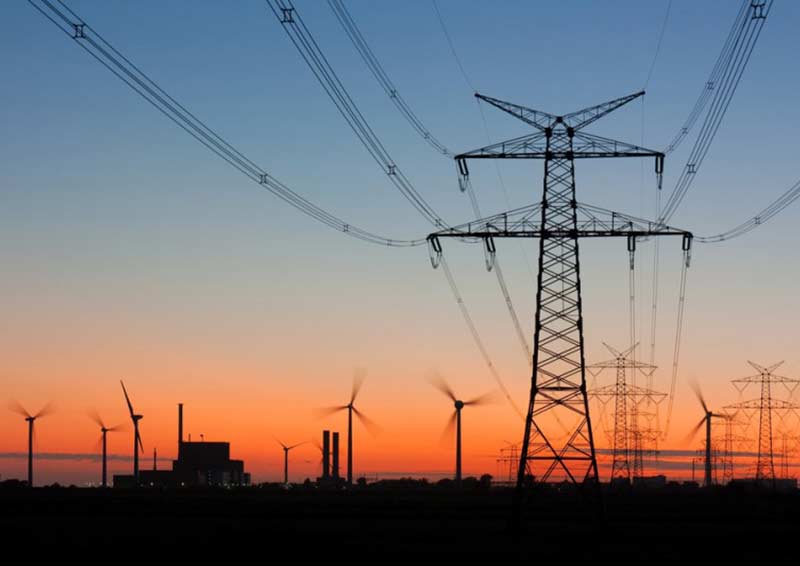Electrical energy
Electrical energy is the term given to energy that has been converted from electric potential energy. This electric potential energy has usually been in turn converted from another source of energy, through a process known as generation.
Electrical energy is supplied by a voltage (or electrical potential) delivered via an electric current.
Electrical power is defined as the rate at which electrical energy is transferred via an electrical circuit over a given amount of time. It is therefore the rate of ‘doing work’. The SI unit of electrical power is the watt, which equates to an energy transfer rate of 1 joule per second.
In the context of buildings, electrical energy is typically converted into other forms of energy, to serve useful purposes such as heating, lighting, motion or other forms of electrical power conversion.
Electrical energy for use in buildings is often supplied via a grid connection, and typically originates at a power station, where it has been generated by electro-mechanical generators. Electrical energy can by generated by many means, such as chemical combustion, nuclear fission, or renewable means such as flowing water, wind, geothermal heat and solar voltaic.
Equally, electrical energy may be generated at the building itself, typically either via solar voltaic, localised electromechanical generators or other renewable sources. Such energy may be used locally within the building or may be exported back into the grid for use by other consumers. Where this latter facility exists, the building and its system are referred to as a ‘prosumer’ – i.e. a simultaneous producer and consumer of electrical energy.
--ECA
[edit] Related articles on Designing Buildings
- Ampere.
- Articles about electricity.
- BEAMA.
- Consumer electronics.
- Consumer units.
- ECA articles.
- ECA.
- Electric lock.
- Electric motor.
- Electrical appliance.
- Electrical consumption.
- Electrical equipment.
- Electrical installation.
- Electrical power.
- Electrical safety.
- Electrician.
- Electricity bill.
- Electricity supply.
- Glossary of electrical terms.
- IET announces release of 18th Edition Amendment 2.
- Voltage.
- Watt.
Featured articles and news
Restoring Abbotsford's hothouse
Bringing the writer Walter Scott's garden to life.
Retired firefighter cycles world to raise Grenfell funds
Leaving on 14 June 2025 Stephen will raise money for youth and schools through the Grenfell Foundation.
Key points for construction at a glance with industry reactions.
Functionality, visibility and sustainability
The simpler approach to specification.
Architects, architecture, buildings, and inspiration in film
The close ties between makers and the movies, with our long list of suggested viewing.
SELECT three-point plan for action issued to MSPs
Call for Scottish regulation, green skills and recognition of electrotechnical industry as part of a manifesto for Scottish Parliamentary elections.
UCEM becomes the University of the Built Environment
Major milestone in its 106-year history, follows recent merger with London School of Architecture (LSE).
Professional practical experience for Architects in training
The long process to transform the nature of education and professional practical experience in the Architecture profession following recent reports.
A people-first approach to retrofit
Moving away from the destructive paradigm of fabric-first.
International Electrician Day, 10 June 2025
Celebrating the role of electrical engineers from André-Marie Amperè, today and for the future.
New guide for clients launched at Houses of Parliament
'There has never been a more important time for clients to step up and ...ask the right questions'
The impact of recycled slate tiles
Innovation across the decades.
EPC changes for existing buildings
Changes and their context as the new RdSAP methodology comes into use from 15 June.
Skills England publishes Sector skills needs assessments
Priority areas relating to the built environment highlighted and described in brief.
BSRIA HVAC Market Watch - May 2025 Edition
Heat Pump Market Outlook: Policy, Performance & Refrigerant Trends for 2025–2028.
Committing to EDI in construction with CIOB
Built Environment professional bodies deepen commitment to EDI with two new signatories: CIAT and CICES.
Government Grenfell progress report at a glance
Line by line recomendation overview, with links to more details.
An engaging and lively review of his professional life.
Sustainable heating for listed buildings
A problem that needs to be approached intelligently.
50th Golden anniversary ECA Edmundson apprentice award
Deadline for entries has been extended to Friday 27 June, so don't miss out!
CIAT at the London Festival of Architecture
Designing for Everyone: Breaking Barriers in Inclusive Architecture.





























